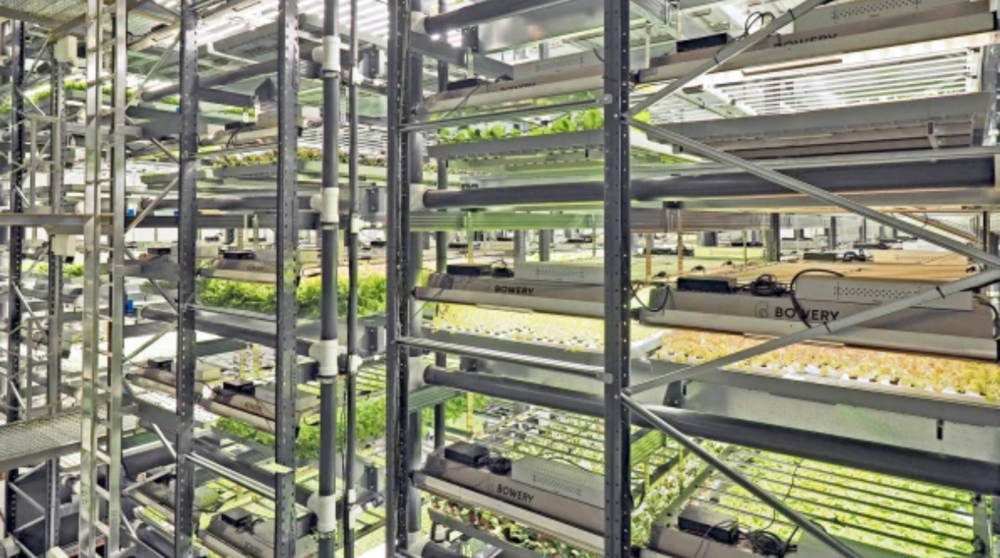Vertical Farming is a cultivation method that offers a range of solutions for future global challenges. To be able to feed the entire world in 2050, we’ll need to produce 70% more food according to the United Nations. At the same time, due to erosion and climate change, scientists expect that the world’s arable land per capita will shrink by 20% (Bayer, September 2021). Realizing that there is a need for a solution to feed the entire population, vertical farming seems to offer promising solutions:
- Farmers can grow their crops year-round
- Crops are unaffected by adverse weather
- Zero use of chemicals and pesticides
- Efficient use of space by layering up the plants
- Reduce water usage by 95%
- Cuts down transportation costs and emissions that come along
- Farmers can control the nutritional values
Sensors, smart energy systems, colored LEDs, AI, and machine learning all can contribute in making vertical farming financially feasible. Because vertical farming is currently very costly and most of the time unprofitable. This is due to high initial costs such as the price of the land. In urban areas where at the moment the majority of the vertical farms are located, are usually very expensive. Moreover, vertical farms have high operational costs which according to pure greens is composed of 57% of labor costs and 12% of energy costs. Labor costs are high because these farms require experts in the field and close monitoring of the plants. Energy costs come from the LEDs used to create artificial light.
Despite the fact that vertical farms can be used for almost any crop available, high operational and initial costs force farmers to grow only a selection of exclusive crops. Those crops are at the moment only sold in gastronomic restaurants or sold at very high prices in the retail stores.
However, there is a belief that advancements in technology and the increasing expertise in the understanding of vertical farming, are seeding new breakthroughs for efficient vertical farms. I am of the opinion that soon, vertical farms will become profitable and mainstream. Partly because; firstly, technologies such as machine learning allow farmers to bolster efficiencies, reducing waste of resources and thus reducing costs of production. Secondly, sensors and cameras retrieve data about the crops’ status in their growth cycle (Piechowiak, 2019). By collecting this data, farmers can identify the best possible moment to harvest. This technology has already shown proof of significant reduction in food waste (avoid rotting), waste of time, and many other benefits. Thirdly, improved LEDs also help to cut costs, by increasing energy efficiency through drastic reduction of heat waste throughout the entire vertical system (Bayer, September 2021). Moreover, the LEDs are editable in a way farmers can change their color in order to adapt to the crops’ specific nutritional needs.
Realizing that machine learning, LEDs, and sensors are still subject to developments and growth, I believe these can provide vertical farming a way to challenge its struggle to be financially feasible. In addition to these technologies, economies of scale will also define the profitability of vertical farming. For that reason, I do not believe that vertical farms in shipping containers that are already marketed, will make radical changes in the farming industry. Or at least, not making vertical farming an attractive source of revenue. Therefore, farms including Bowery in the US (https://boweryfarming.com) or the German company &Ever (https://and-ever.com), seem to be promising business models. Nevertheless, there is much to debate about and as our environment and capacity to feed people is coming under high pressure, vertical farming is rising as a complementary way of farming in the pursuit of sustainability, food waste and food supply.
References
Bowery. (2021) Bowery: Vision. Retrieved from https://boweryfarming.com.
Eckhardt, J. (2021) Urban Farming: Growing Vegetables in Cities. Bayer Global. Retrieved from https://www.bayer.com/en/af/news-stories/urban-farming-growing-vegetables-in-cities?gclid=Cj0KCQjw-4SLBhCVARIsACrhWLU5971yYhLkLdTABOIAjs7auWbzjXrR7iGjx6IdRjCMaDRV_5mDjKUaAhjZEALw_wcB&gclsrc=aw.ds.
Piechowiak, M. (2019) Why is Vertical Farming Bad? Vertical Farming Planet. Retrieved from https://verticalfarmingplanet.com/why-is-vertical-farming-bad-9-disadvantages/.
&Ever (2021) &Ever: Technology, &Ever MegaFarm. Retrieved from https://and-ever.com.


